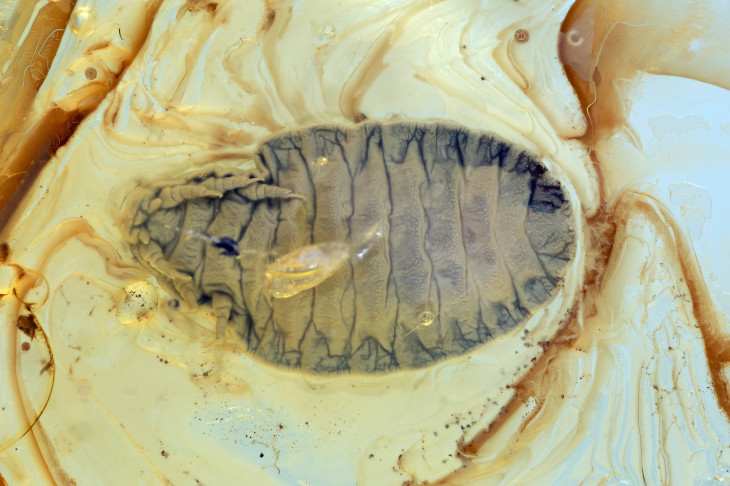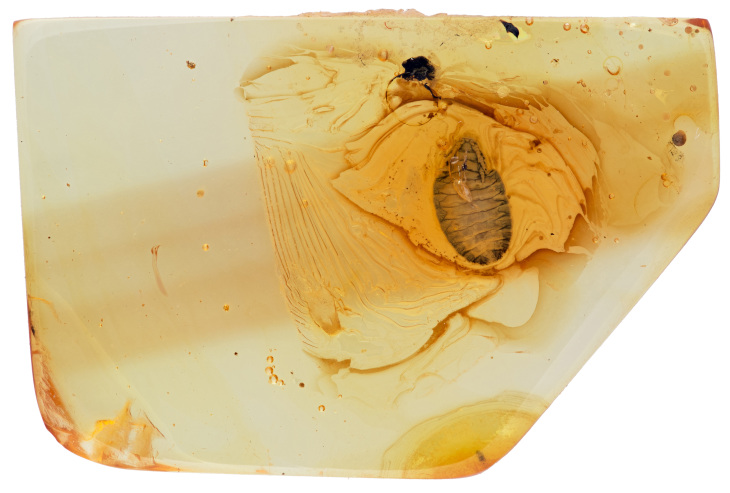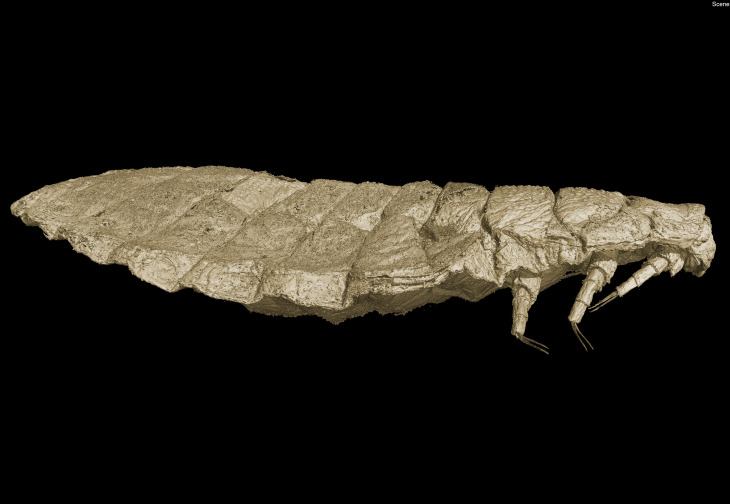Amber fossils in X-ray light
50-million-year-old larva of the order Strepsiptera was examined by materials researchers of the Helmholtz Centre Geesthacht

Belly view of the larvae of a Strepsiptera enclosed in a Baltic amber of only about five millimetres in size. Photo: Hans Pohl/FSU
When biologist Dr Hans Pohl from Jena University discovered an insect fossil encased in amber on eBay, he was thrilled with what he’d found: a 50-million-year-old larva of the order Strepsiptera. But to study this very special specimen in detail, he had to enlist the help of the materials scientists at the Helmholtz-Zentrum Geesthacht (HZG). The research team has now published their findings in the journal Arthropod Systematics & Phylogeny, along with some spectacular photos.
The Strepsiptera are parasites that attack other insects such as bees and wasps, as well as silverfish. “In most of the 600 or so known species, the females spend their entire lives inside their host,” says Pohl, a biologist at the Friedrich Schiller University Jena. “Only the males ever leave, to go on their nuptial flight, but after that they only survive for a few more hours.” There are exceptions, however: in species that infest silverfish, flightless females leave their hosts as well.
Fossil around 50 million years old

The fossil in amber. The age lies between 42-49, maximum 54 million years. This fossil was scientifically examined at the Institute for Zoology and Evolutionary Research with the Phyletisches Museum, Ernst-Haeckel-Haus and Biologiedidaktik of the University of Jena. Photo: Hans Pohl/FSU
Not long ago, the researchers in Jena were able to make a remarkable discovery: they successfully identified a nearly 100-million-year-old fossil of a Strepsiptera larva in the first stage of development, encased in a piece of amber. Measuring just about 0.2 millimetres in length, such larvae are considered to be amongst the smallest multicellular organisms that have ever existed.
Then, Pohl happened to come across a seller on eBay who was offering a piece of Baltic amber with an insect inclusion. “I noticed right away that what they were selling was a one-of-a-kind fossil,” the biologist explains. After some hard bargaining, he was able to secure this little treasure for himself at a price of €1,000. The 4.4-millimetre-long creature became entrapped in tree resin approximately 50 million years ago and was sealed inside. It’s the first known fossil of a Strepsiptera species in a larval stage beyond the first one.
Microtomography with synchrotron radiation provides 3D image

HZG microtomography: Computer-generated image of a Strepsiptera larva (side view) enclosed in a Baltic amber of only about five millimetres in size. Photo: Hans Pohl/FSU
The problem, according to Pohl, was that “Under an optical microscope, it was impossible to make out certain very important details. We couldn’t tell if the larva had antennae or not, nor could we see how the eyes or mouthparts developed, or if the larva we were dealing with was male or female.” So the team decided to examine the specimen using a special high-resolution X-ray procedure: microtomography with synchrotron radiation.
To do this, they needed to draw on the resources of a major scientific instrumentation facility, the PETRA III storage ring at the German Electron Synchrotron (DESY) research centre in Hamburg. HZG maintains an outstation at DESY that is primarily involved in materials science research. “The method,” says HZG researcher Dr Jörg Hammel, “is a lot like a CT scanner at the hospital, which is an X-ray machine that gives us three-dimensional images from inside the body.”
![HZG beamline scientists Dr. Jörg Hammel at a device at PETRA III at Deutsches Elektronen-Synchrotron DESY in Hamburg. [Photo: HZG/Christian Schmid] Dr. Jörg Hammel at an apparatus at the storage ring](/imperia/md/images/hzg/presse/pressemitteilungen/2019/fittosize__730_0_7bdf9e55d22be7afaa86516de34f1c60_hzg-petra-beamline__58_.jpg)
HZG beamline scientists Dr. Jörg Hammel at a device at PETRA III at Deutsches Elektronen-Synchrotron DESY in Hamburg. [Photo: HZG/Christian Schmid]
But whereas ordinary X-ray tubes are enough for the kind of imagining done in a clinic, the HZG outstation uses a particle accelerator that’s more than two kilometres long as its light source. “The X-ray beam generated by PETRA III is extremely intense,” explains Hammel. “This allows us to produce incredibly sharp images, even when the sample is very small.” During the imaging process, the sample is rotated in the beam to allow images to be captured from all sides. Each individual shot taken looks like a normal X-ray image; the computer then takes them all and puts them together to create a 3D image.
In the case of the Strepsiptera larva, this method yielded incredibly sharp images with a resolution of 1.3 micrometres. “This allows us to see all the important details,” Pohl says, pleased with the results. “One of the things we were able to determine was that the specimen was probably in the third larval stage, and also that it’s highly likely that we’re looking at a female larva of the genus Mengea, which is now extinct.” What was truly remarkable, however, is that this female had left its host, a behaviour that in modern species is only known amongst those that attack silverfish. Also: “There’s some evidence to suggest that the host was a cockroach,” Pohl speculates. “But in order to be certain we’d have to track down more fossils like this and thoroughly examine them.”
It’s quite possible that these specimens will be examined using the storage ring again. “In the past few years, the HZG outstation seems to have become pretty popular amongst biologists,” says Jörg Hammel. “We’re apparently so good for analysing fossils in amber that we keep getting more and more inquiries from the experts.”
Original Publication:
Hans Pohl, Jörg U. Hammel, Adrian Richter, Rolf G. Beutel: „The first fossil free-living late instar larva of Strepsiptera (Insecta)“, in Arthropod Systematics & Phylogeny, 2019, DOI: 10.26049/ASP77-1-2019-06
Contact
Helmholtz-Zentrum Geesthacht
